Wednesday, September 16, 2020
Tuesday, September 8, 2020
Organic Mulch
Organic Mulch Right from your Yard!
If you're looking for an organic approach to your mulch, there are some good substitutes, and some of the ingredients for it can be found right in your own backyard!
Saturday, September 5, 2020
Great Gifts for People Who Can Food
Great Gifts for People who Can Food
Looking for a great gift for that relative or friend who is into canning food?
Friday, September 4, 2020
Great Gifts for Older Gardeners
Great Gifts for Older Gardeners
We all want our older loved ones to keep healthy, and their love of gardening is a great way for them to do so.
The rigors of gardening, such as bending, stooping, kneeling, squatting, gripping, lifting and the like can be good exercise, but it can also be pretty taxing on an older body.
Tuesday, September 1, 2020
Creating a Rock Garden that Rocks!
Creating a Rock Garden that Rocks --With Hostas!
A rock garden by design is a small plot (usually on a slope or man-made hill) designed to emphasize a variety of rocks, stones, and plants. Rock gardens can be made to blend into the landscape or they can be a great focal point area. Rocks are naturally beautiful, and with the right planning, your rock garden will look good year-round.
Monday, August 31, 2020
Top Ten Hostas to Brighten Up Your Shade Garden
Top Ten Hostas to Brighten up your Shade Garden
Shady garden spaces don't have to be bland. There are the usual colorful shade perennials like the usual suspects like Astilbe, Foxglove and Bleeding Hearts. Those are good perennial shade garden plants to use in adding some bright colors to a shady garden spot.
But have you ever considered incorporating bright-colored hostas into your shade garden layout?
Saturday, August 29, 2020
Epsom Salt in the Organic Garden
Epsom Salt in the Organic Garden
The popularity of organic gardening is increasing day by day. Organic gardeners have a philosophy that supports the health of the whole system of gardening, especially when it comes to dealing with the soil. As organic gardeners look for alternatives to synthetic pesticides and fertilizers, Epsom Salt has risen in popularity as an effective organic soil amendment for garden use.
Saturday, August 22, 2020
Friday, August 21, 2020
Growing Lettuce - Homesteading 101
No homesteading garden is complete without growing the foundation of your salad garden, lettuce!
Growing lettuce is easy, takes up little space so you can easily tuck it between and under taller vegetables and even flowers.
Lettuce grows for many weeks in the mild weather of spring and fall, and it can be planted several times every season for a continual supply.
The Basics -- Lettuce
Annual Height: 9-12: Width: 6"
Lettuce comes in many different varieties including leaf lettuces, crispheads, summer crisps, icebergs, romaine, butterheads, and bibbs. Here's a short description of each.
Leaf lettuce. Forms a loose rosette of tender, sweet-tasting leaves in 4-6 weeks.
Summer Crisps. Loosehead of large, crisp leaves with good flavor.
Crispheads. A combination of romaine and iceberg types. Crunchy texture.
Romaines. Oblong leaves that form fairly loose, upright heads.
Butterhead and Bibb. Broad rosettes of tender, wavy leaves with a delicate flavor and creamy texture.
There are early varieties for spring planting and heat-tolerant varieties for Fall planting.

Starting Seeds of Lettuce
Seed Depth: 1/4" - 1/2". Need light to germinate.
Seed Spacing: Thin to 6-8" apart.
Days to Germinate: 7-14 days.
Days to Harvest: Leaf Lettuce 30-50 days.
Head Lettuce 100 days.
Seed Longevity: 2 Years
Sowing Indoors:
Start Romaine, iceberg and other head lettuces indoors 4-6 weeks before the average last frost date, making three small sowings at weekly intervals.
Sowing Outdoors:
Spring: Direct sow as soon as soil can be worked.
Fall: Direct sow 4-8 weeks before your average first frost date.
Salad Spinner

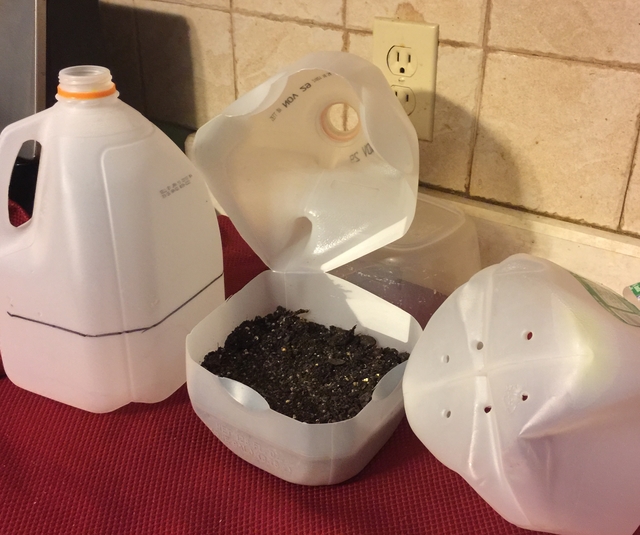
Winter Sowing:
If you haven't tried winter sowing, you're in for a treat. This method is especially good for sowing herbs and greens.
Winter sowing is basically sowing seeds in the bottom of a milk jug during the winter, setting the milk jugs outside for the winter and leaving them there until the seeds germinate in Spring.
For our separate article with details about Winter Sowing, click here.
Salad Tongs

Growing Lettuce Plants
Growing Temperature: 55-60 degrees during the growing season. Will survive light frosts.
Plant Spacing: Leaf Lettuce - 1" for continuous harvest.
Head Lettuce - 8"
Summer Crisps - 8-12"
Iceberg - 8-12"
Romaine - 10"
Butterhead - 8-10"
Bibb - 6-8"
Container Size: Shallow Roots. 6" deep.
Sun/Shade: Full sun for best yields. Tolerates part shade.
Soil: Plenty of compost will encourage fast growth.
Watering: Consistent water for the best flavor.
Lack of moisture causes bitterness.
Try Audible and Get Two Free Audiobooks
Fertilizing
Since greens are such a fast-growing crop, as long as they are grown in rich soil there may be little need for further fertilization.
That said, a liquid balanced fertilizer when the seedlings are 4" tall will give your greens a boost and carry them through their short season. After the temperatures warm, though, the leaves of Lettuce will turn bitter and no amount of fertilizer will help at that point.
Growing Tips
Extending the Growing Season:
Start romaine, iceberg and other head lettuce indoors 4-6 weeks before the average last frost date, making three small sowings at weekly intervals.
Set out the seedlings and direct sow leaf lettuce outdoors at 2-week intervals. If you plan to harvest only leaves, sow entire loose-leaf crop at once.
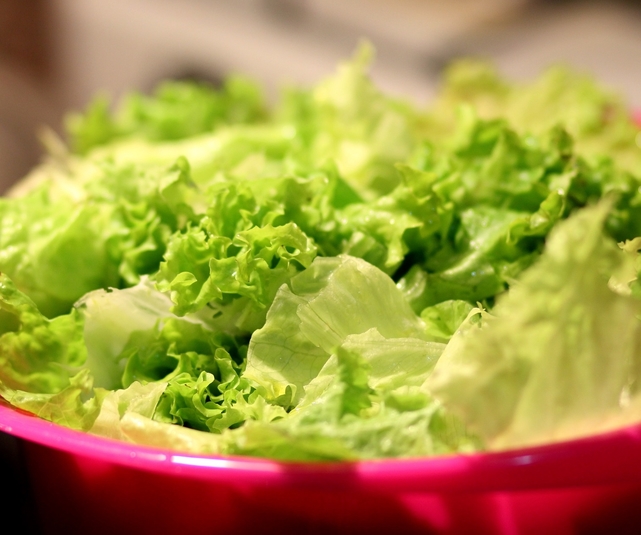
Harvesting Lettuce
Leaf Lettuces. Harvest outer leaves as soon as they're a usable size.
Harvest entire plant at 2" above soil level for cut-and-come-again.
Head Lettuces. Cut the head away from the stalk when the head is still firm. Head lettuce will be freshest when harvested in the morning.
Salad/Food Crispers

Storing Lettuce For Later Use
Tendergreen leaves, like Lettuce, can't be preserved well.
FreshLoose leafed lettuce will store 7-10 days in a crisper.
Head lettuce will store 1-3 weeks in the crisper
~~~~~~~~~~~~~
To read the other articles in our Homesteading 101 Growing Your Greens series, click on the name below:
Where to go next!
Great Garden Articles -- Full List!
Follow us on Pinterest!
Hit the "Follow Button" Our Blog Homepage!
This post may contain some Amazon Associate links meaning that I will get a small compensation at no expense to you if you purchase something from this blog.
Wednesday, August 19, 2020
Best Hostas for Beginners
Best Hosta Choices for Beginners
One of the reasons that hostas have remained so popular in the perennial garden is the beauty of their leaves. For the first-time hosta grower, though, there are some hostas that are easier to grow and care for than others.
Tuesday, August 18, 2020
Best Soil for Hostas
Best Soil for Hosta Plants
If you've heard that hostas can grow in any soil type, even poor soil, that's not exactly true. While established hostas tend to become comfortable in any soil over time, they certainly won't thrive and retain the beautiful leaves that you grow them for. Young hostas planted in poor soil will eventually succumb to disease and die.
If you want your hostas to thrive, the key is soil that is rich. The ideal soil pH for hostas ranges from 6.5 to 7.5, which actually means it's slightly acidic to slightly alkaline.
Sunday, August 16, 2020
Care of your TerraCotta Pots
How to Clean Terracotta Pots
A big advantage of terracotta is its ability to absorb water from the soil. But because it will also absorb chemical fertilizers and salts found in tap water, that buildup of a crusty residue needs to be removed for the pot to be safely reused the next garden season.
Although that aged terracotta look is pleasant to some, dirty pots can harbor fungus, mold, diseases, and pests. Regular maintenance of cleaning and disinfecting them is a good garden habit to get into.
Saturday, August 8, 2020
Great Gifts for Bird Lovers!
Great Gifts for Bird Lovers!
Whether it's a birthday gift, Mother's Day, Christmas, or just a thank you for that bird lover you know, here are some great gift ideas!
Thursday, August 6, 2020
Growing Arugula -- Homesteading 101
aka Rocket Roquette
The leaves of Arugula provide a spicy zing when added to salads. It will grow a rosette about a foot wide and equally as tall. It's a cut-and-come-again plant. It boasts several health benefits. It is an excellent source of fiber, rich in Vitamins A, C, and K as well as a good source of calcium, iron, magnesium, phosphorus, and potassium.
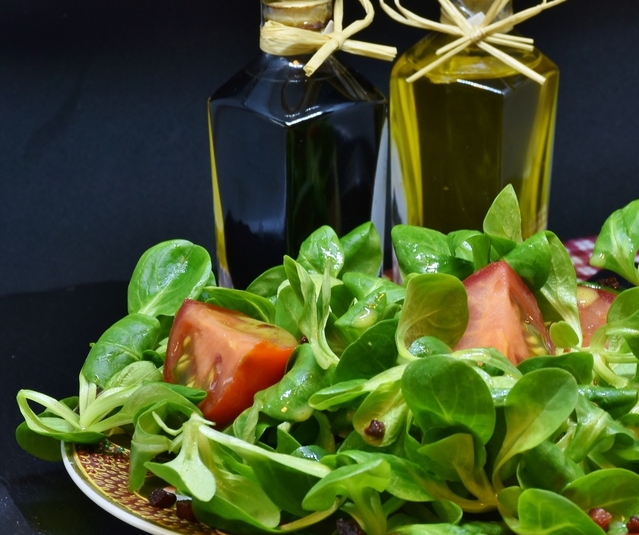
Types:
Wild Arugula. Grows up to 2' tall with jagged leaves and a yellow flower.
Rocket Salad. A weaker peppery flavor. The plant grows up to 3' tall. It has lobed leaves and a white flower.
Starting Seeds of Arugula
Seed Depth: 1/8" on the soil surface and tamp down.
Seed Spacing: 3-4" Thin to 4-6".
Days to Germinate: 7-14 days.
Days to Harvest: 3 weeks/baby leaves, 45 days mature.
Seed Longevity: 4 years.
Sowing Outdoors
Salad Spinner

Winter Sowing
If you haven't tried winter sowing, you're in for a treat. This method is especially good for sowing herbs and greens. Winter sowing is basically sowing seeds in the bottom of a milk jug during the winter, setting the milk jugs outside for the winter and leaving them there until the seeds germinate in Spring.
To see our detailed article about Winter Sowing, click here.
Salad Tongs

Growing Arugula Plants
Growing Temperature:
Arugula is frost hardy enough that it can grow through the winter in a cold frame or unheated greenhouse.
Plant Spacing: 12-18" apart.
Container Size: 8" depth is enough.
Sun/Shade: Full sun, some mid-day shade.
Soil: Rich, compost.
Watering: Consistent moisture for best flavor.
Salad Lunch Container

Fertilizing:
Since greens are such a fast-growing crop, as long as they are grown in rich soil there may be little need for further fertilization. That said, a liquid balanced fertilizer when the seedlings are 4" tall will give your greens a boost and carry them through their short season. After the temperatures warm, though, the leaves of Arugula will turn bitter and no amount of fertilizer will help at that point.

Harvesting Arugula
Harvest when leaves are 4-6" tall. Harvest outer leaves. Harvest until leaves taste too strong. Harvesting often will encourage new growth.Using Arugula
- A great addition to any salad, but use sparingly for a mustard-like flavor.
- Pizza toppings.
- Add Arugula flowers to salads in late spring and summer for their peppery flavor.
- Cook larger leaves with other greens.
- Small leaves tend to be milder while the larger has a more peppery taste.
- Arugula goes well with most meats, especially grilled meats.
Storing Arugula For Later Use
Remove Arugula's tough stems, clean and dry.Although tender green-leafed plants, like lettuce, cannot be preserved well, the thicker leafed greens can be preserved.
Fresh
- Clean and pat dry. Bundle stems lightly, place on a paper towel (to absorb moisture) and wrap in a plastic bag. Keeps in refrigerator for 10 days.
- Steam or saute' leaves, chop them and store in freezer bags.
- Puree with water and freeze into ice cube trays.
- Clean and dry the leaves and store in quart size freezer bags.
- Frozen leaves will keep for 6 months.
- Blanching the leaves for two minutes first will extend freezer storage to 14 months.
To read the other articles in our Growing Your Greens series, click on the name below:
Swiss Chard
Great Garden Articles -- Full List!
Where to go next!
Great Garden Articles -- Full List!
Follow us on Pinterest!
Back to Our Blog Homepage!
This post may contain some Amazon Associate links meaning that I will get a small compensation at no expense to you if you purchase something from this blog.
Wednesday, August 5, 2020
Hostas as Houseplants
Hostas as Houseplants
If you’re looking for a houseplant to grace your windowsill from spring to fall, hostas are a perfect choice. They will need some winter care, which you’ll read about later.
Tuesday, August 4, 2020
Growing Mustard Greens - Homesteading 101
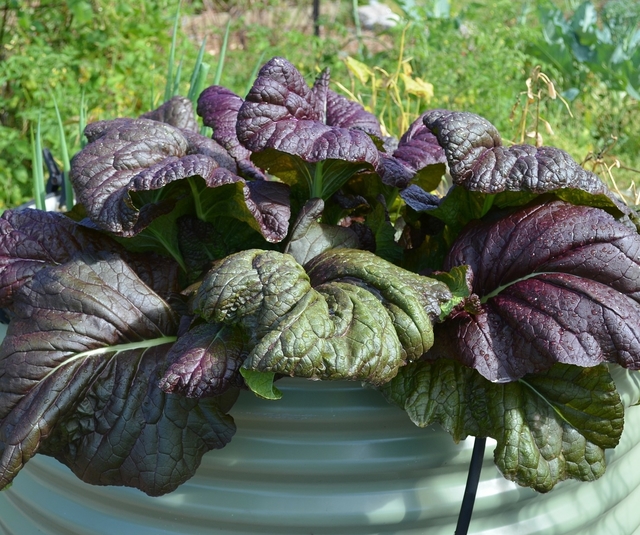
Mustard Greens
aka Mizuna, Mustard Spinach, Indian MustardAnnual plant
Height: 6" Width: Up to 2'
Mustard Greens are a leafy plant with a zesty mustard flavor that is a fiber and nutrient-rich addition to salads and stir-fries.
Types:
Curly Leaf. Curled or frilled leaf edges resembling Kale. It's a very spicy tender green used in salads.
Flat Leaf. Broad delicately flavored leaves are good for steaming or in soups.
Mustard Spinach. Smooth leaves. This plant is more tolerant of heat, making it a good choice in warmer climates.
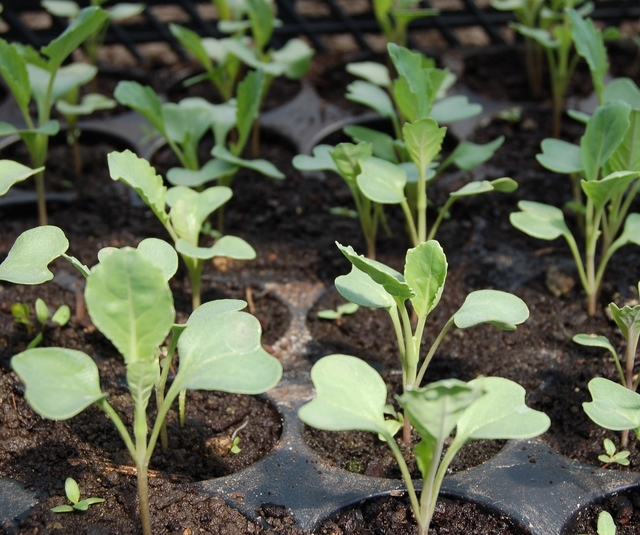
Starting Seeds of Mustard Greens
Seed Depth: Lightly cover the seed and tamp down on the soil.
Seed Spacing: 6" apart, and thin to 19" apart.
Germination Temp: 45-85 degrees.
Days to Germinate: 4-7 days.
Days to Harvest: 30-40 days or 60-70 days depending on the variety.
Seed Longevity: 2-3 years.
Sowing Indoors:
Spring: Sow 6 weeks before your average last frost date. Plant out 3 weeks before your average last frost date.Sowing Outdoors:
Spring: Direct sow 3-4 weeks before your average last frost date.Salad Spinner


Winter Sowing:
If you haven't tried winter sowing, you're in for a treat. This method is especially good for sowing herbs and greens. Winter sowing is basically sowing seeds in the bottom of a milk jug during the winter, setting the milk jugs outside for the winter and leaving them there until the seeds germinate in Spring.For more detailed information about Winter Sowing, click here.
Salad Tongs

Growing Mustard Green Plants
Growing Temperature: Tolerates light frosts which make leaves sweeter.
Plant Spacing: 12"
Container Size: 8" deep.
Sun/Shade: Sun is ideal. It also tolerates shade.
Soil: Moist, rich, well-draining.
Watering: Evenly moist for best flavor. 2" water per week.
Try Audible and Get Two Free Audiobooks
Fertilizing
Since greens are such a fast-growing crop, as long as they are grown in rich soil there may be little need for further fertilization. That said, a liquid balanced fertilizer when the seedlings are 4" tall will give your greens a boost and carry them through their short season. After the temperatures warm, though, the leaves of Arugula will turn bitter and no amount of fertilizer will help at that point.Salad Lunch Container

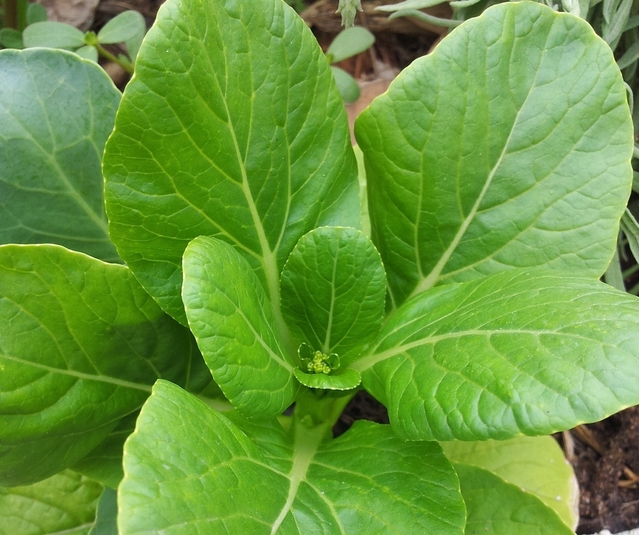
Growing Tips
Sow Mustard Greens in succession every 2-3 weeks for a steady supply.
Harvesting Mustard Greens
Begin harvesting outer leaves in about 4 weeks when the leaves are 6-8" long, or treat as cut-and-come-again and harvest the whole plant 3" above ground level.
Using Mustard Greens
- Use smaller Mustard Green leaves in salads or on sandwiches for a peppery zing.
- Use steamed, braised, cooked in broth.
Storing Mustard Greens For Later Use
Although tender green leaves, like lettuce, cannot be preserved well, the thicker leaved greens can be preserved.Fresh
- Clean and pat dry. Bundle stems lightly, place on a paper towel (to absorb moisture) and wrap in a plastic bag. Keeps in refrigerator for 10 days.
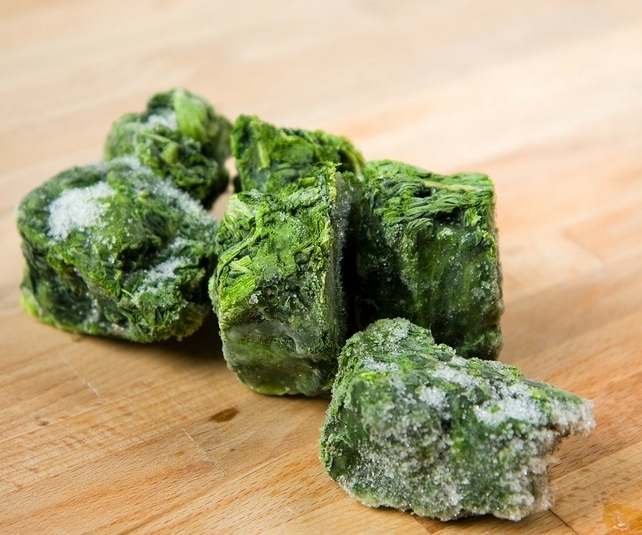
Freezing for Later Use in Chilis, Soups, Sauces, and Casseroles.
- Steam or saute' leaves, chop them and store in freezer bags.
- Puree with water and freeze into ice cube trays.
- Clean and dry the leaves and store in quart size freezer bags.
- Frozen leaves will keep for 6 months.
- Blanching the leaves first for two minutes will extend freezer storage to 14 months.
To read the other articles in our Growing Your Greens series, click on the name below:
Swiss Chard
This post may contain Amazon affiliate links and as an Amazon Associate I earn from qualifying purchases without costing you anything extra.
Check out our other great gardening articles: Click Here
This post may contain Amazon affiliate links and as an Amazon Associate I earn from qualifying purchases without costing you anything extra.
Subscribe to:
Posts (Atom)
Popular Posts
-
Use of Epsom Salt on Hostas! Hostas continue to be one of the most popular perennials in shady and party shady gardens. It's n...
-
Fertilizing Your Hosta Plants It's no surprise that hostas continue to be one of the most popular perennial plants in a variety ...
-
What are Sun Tolerant Hostas? One of the most common questions I hear about hostas is, can hostas handle sun?
-
When and How to Divide your Hosta Whether you want to divide your hostas for the healthy of the plants or to increase the hosta love...
-
Winter Sown Seeds Have Germinated! Now what? So you’ve tried the winter sowing method and found out that it’s easy and it works....
-
Best Care for Your Potted Hostas To keep your hostas healthy and beautiful as they grow in pots, there are a few Hosta plants are beau...
-
Seasonal Calendar of Care for Hostas One of the reasons that hostas continue to be so popular is the fact that they're a very low m...






























